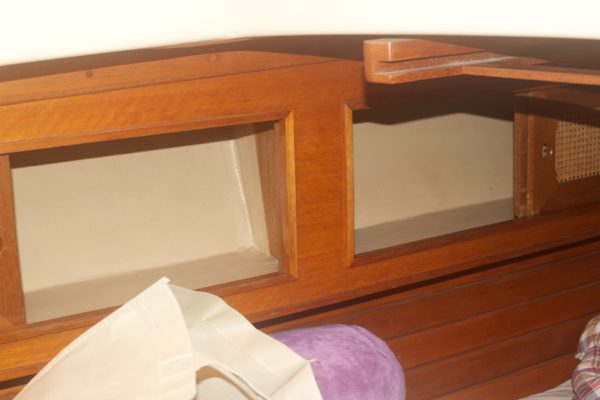We have had issues with condensation in the winter. Not horrible ones like some people have had where water is raining down from the roof in their cabin, but issues nonetheless. Ours is really isolated to the cabinets that run along the sides of the inside of the boat from bow to stern. We sometimes forget the cause of the condensation and wind up with puddles of water inside the cabinets. For us, the cause is trying to keep the warm air in and completely buttoning up Emet with two small space heaters on, cooking a pot of hot soup, and having two smalls dogs and a cat. This is a perfect recipe for condensation: lots of moisture with nowhere for it to go and creating a fairly large temperature differential between the inside of the boat and the very cold outside.
What can be done?
1. Just Ignore It
- This is probably the easiest thing to do. And one . . . ahem . . . that we’ve employed on the rare occasion. There is nothing like simply turning a blind eye towards a problem and hoping for the best. For the most part, condensation on a boat doesn’t really hurt the boat as long as the boat isn’t neglected. I suppose it’s similar to getting water in from a breaking wave or a rain shower or coming in soaking wet from a swim. The real issue is the stuff that can be damaged from moisture and the ensuing mold and mildew: books, pictures, electronics, clothes, etc. We’ve made a few mistakes and had some condensation absolutely soak cardboard boxes and get the corners of some books wet.
2. Move the Boat to a Warmer Climate
- This will definitely fix the condensation problem, but then there’s the whole, “5$!#, it’s hot and humid and the sheets are all damp” issue that Jodi loves so much to hate. I would prefer this problem to liquid water running down the inside of the hull of Emet. And I am partial to hot and damp sheets over cold and damp sheets.
3. Use Dehumidifiers
- This would definitely solve the problem — if you have the space and power for them. I reckon that a single typical household room dehumidifier would be sufficient to keep the inside of Emet dry enough to prevent condensation. But, then there’s the whole issue of having to empty the condensate bucket and the contraption taking up space and power.
4. Insulate the Boat
- Definitely the best solution. The trick here is to ensure that it is properly done. The insulation must be completely bonded to the hull of the boat. Once done, the cold hull is insulated from the warm and moist air inside the boat and the condensation issues are non-existent at from then on. When we were at Blue Dolphin a friend with a steel hull boat built in Seattle was there. The entire inside was insulated with spray foam. It was applied during construction and his boat was cool in the summer and warm in the winter.
5. Ensure There is Positive Ventilation Through the Boat
- And this is our solution, which we sometimes forget about. It’s probably the healthiest of all as it ensures a supply of fresh air is coming through the boat. We keep the dorade vents open, slightly open the two port lights, and leave one of the cabin top hatches cracked. This does make for a slightly colder interior, but it keeps the air circulating and replaces our warm moist air with some cool drier air. We’ve found that as long as we do this, condensation is pretty non-existent. The other trick is to make sure there is nothing that is resting against the hull and trapping moist air against it. There has to be good air flow all around everything.

The port settee cabinets AFTER we cleaned all the condensation up, let it dry out, and then carefully put everything back in. We left the doors open to allow for better air flow even though the doors have wicker fronts.

Port v-berth cabinets. Jodi keeps some of her clothes in here and we just haven’t figured out how to keep them from trapping moisture against the hull. They are empty while we think about it.
If something is really important and is to be kept on a boat, probably the best thing would be to vacuum bag it. We don’t have a vacuum bagger. We have, however, done our best to get rid of stuff and we are fairly vigilant about looking after the stuff that we do have that is important.
